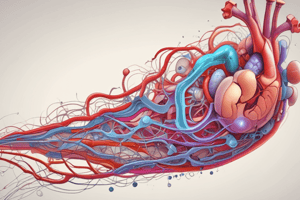Podcast
Questions and Answers
What are 5 main functions of the Kidneys?
What are 5 main functions of the Kidneys?
- Regulation of ions in blood. (filters blood) 2. Regulation of blood volume 3. Regulation of blood pH 4. Production of hormones 5. Excretion of waste
What 2 hormones do the kidneys produce?
What 2 hormones do the kidneys produce?
Erythropoietin and renin
What is the importance of Erythropoietin?
What is the importance of Erythropoietin?
Helps regulate red blood cell production
What is the importance of renin?
What is the importance of renin?
What is a function of the kidneys related to water concentration
What is a function of the kidneys related to water concentration
What are the 3 function components of the Kidney?
What are the 3 function components of the Kidney?
Match each component to its function
Match each component to its function
Match each component to its importance
Match each component to its importance
List the layers of supportive tissue, that surround each kidney, from superficial to deep
List the layers of supportive tissue, that surround each kidney, from superficial to deep
Match the function to its supportive tissue
Match the function to its supportive tissue
Match
Match
Put these in order of occurance
Put these in order of occurance
How do the kidneys assist during periods of starvation
How do the kidneys assist during periods of starvation
What is the functional unit of the kidneys?
What is the functional unit of the kidneys?
List the 5 arteries in sequential order:
interlobar, cortical, segmental, renal, arcuate
List the 5 arteries in sequential order: interlobar, cortical, segmental, renal, arcuate
Name the 5 arteries, after the aorta, in sequential order
Name the 5 arteries, after the aorta, in sequential order
List in sequential order, the veins that blood return via to reach the inferior vena cave
List in sequential order, the veins that blood return via to reach the inferior vena cave
What is the renal plexus?
What is the renal plexus?
What role do sympathetic vasomotor fibers play?
What role do sympathetic vasomotor fibers play?
Which vein drains deoxygenated blood from the kidneys?
Which vein drains deoxygenated blood from the kidneys?
The renal arteries branch directly from the:
The renal arteries branch directly from the:
Which of the following structures is not found in the renal hilum?
Which of the following structures is not found in the renal hilum?
The triangular regions of the kidneys that are striped in appearance and separated by the renal columns are the:
The triangular regions of the kidneys that are striped in appearance and separated by the renal columns are the:
The tube that conveys urine from the kidney to the bladder is the:
The tube that conveys urine from the kidney to the bladder is the:
The renal plexus is primarily associated with which type of nervous system activity?
The renal plexus is primarily associated with which type of nervous system activity?
The renal corpuscle is located in which part of the kidney?
The renal corpuscle is located in which part of the kidney?
Briefly describe the gross anatomy of the kidney
Briefly describe the gross anatomy of the kidney
Explain the broad function of the renal arteries and veins in the urinary system
Explain the broad function of the renal arteries and veins in the urinary system
Discuss the role of the ureters in the urinary system
Discuss the role of the ureters in the urinary system
What is the renal corpuscle, and what role does it play in the urinary system?
What is the renal corpuscle, and what role does it play in the urinary system?
What is the function unit of the kidney called?
What is the function unit of the kidney called?
The main function of the proximal convoluted tubule is:
The main function of the proximal convoluted tubule is:
Describe the function and structure of a Nephron?
Describe the function and structure of a Nephron?
Which part of the nephron is primarily responsible for concentrating the urine?
Which part of the nephron is primarily responsible for concentrating the urine?
The thin segment of the loop of Henle is permeable to which of the following?
The thin segment of the loop of Henle is permeable to which of the following?
The renal papillae drain into:
The renal papillae drain into:
Discuss the importance of the glomerulus and Bowman’s capsule in the renal corpuscle
Discuss the importance of the glomerulus and Bowman’s capsule in the renal corpuscle
Explain the role of the Loop of Henle in the concentration of urine
Explain the role of the Loop of Henle in the concentration of urine
Discuss the functions of the proximal and distal and convoluted tubules
Discuss the functions of the proximal and distal and convoluted tubules
Match
Match
Flashcards are hidden until you start studying



